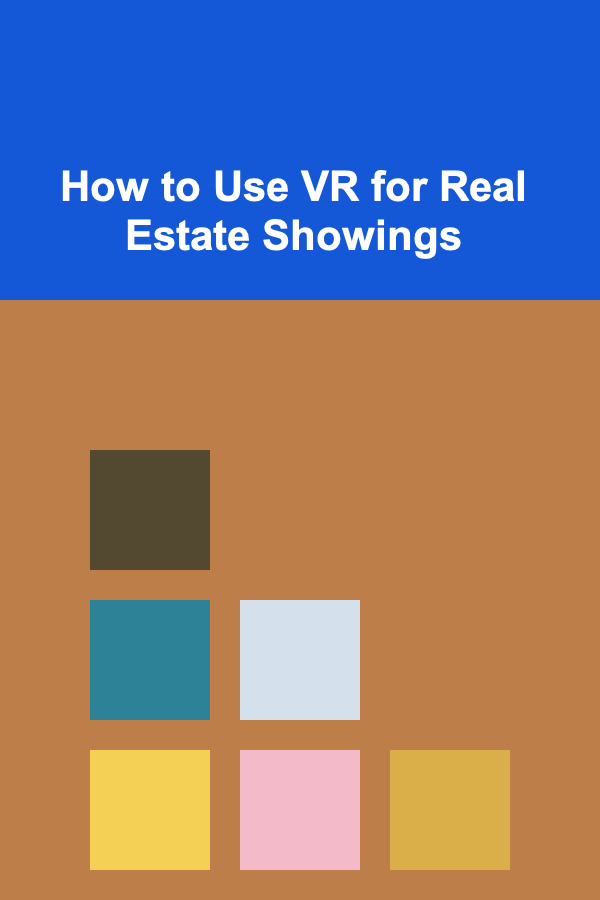
How to Use VR for Real Estate Showings
ebook include PDF & Audio bundle (Micro Guide)
$12.99$9.99
Limited Time Offer! Order within the next:

Virtual Reality (VR) has revolutionized various industries by providing immersive and interactive experiences. Among these industries, real estate is one of the most significantly impacted, especially in how properties are shown to potential buyers. Traditional real estate showings, where prospective buyers visit properties in person, can be time-consuming and limited by geographic and logistical constraints. However, VR technology enables agents to offer virtual tours of properties from anywhere in the world, making it a game-changer for both buyers and sellers.
This article will explore how VR is transforming real estate showings, the technology behind it, and the benefits and challenges associated with its use. Additionally, we will delve into the practical steps involved in using VR for real estate, the tools required, and how to make the most of this cutting-edge technology for a successful real estate business.
The Role of VR in Real Estate
In traditional real estate, showings are typically organized when a potential buyer expresses interest in a property. However, scheduling in-person showings can be a hassle for both agents and buyers, particularly if the property is in a different city or country. VR technology addresses this challenge by allowing buyers to "walk through" a property virtually, from the comfort of their own home.
VR for real estate showings allows prospective buyers to experience a property in an immersive environment, offering them a sense of the layout, scale, and atmosphere of the home. It enables them to view multiple properties without physically traveling to each location, saving time and resources. Additionally, VR can help agents provide a more engaging and detailed viewing experience compared to static photos or videos.
The Technology Behind VR Real Estate Showings
Virtual reality in real estate relies on a combination of hardware and software. The primary hardware used for VR experiences includes VR headsets, controllers, and sometimes additional accessories like motion tracking sensors or haptic feedback devices. On the software side, VR real estate experiences are typically created using 3D modeling and virtual tour software.
1. Hardware for VR Real Estate
- VR Headsets: These are the most essential component of a VR system. Popular VR headsets include the Oculus Rift, HTC Vive, and PlayStation VR. These headsets provide an immersive experience by displaying 3D visuals in a 360-degree environment. They are equipped with sensors that track the user's head movements to adjust the visuals accordingly, ensuring that the user feels like they are physically present within the virtual property.
- Controllers and Motion Sensors: These devices allow users to interact with the virtual environment. In the case of real estate showings, users can "move" through the property, open doors, or zoom in on specific details, just as they would in a real-world showing.
- Haptic Feedback: Some VR setups include haptic feedback devices, such as gloves or vests, which simulate physical sensations. While not always necessary for real estate showings, these can enhance the experience, making users feel as though they are physically interacting with the space.
2. Software for VR Real Estate
To create a virtual property tour, real estate professionals typically rely on specialized software. These platforms allow them to capture 3D scans of properties or design virtual environments from scratch. Some of the most commonly used software for creating VR real estate tours includes:
- Matterport: A popular 3D scanning tool that creates virtual tours by capturing high-definition 3D images of a property. Matterport is widely used for creating interactive floor plans, 3D walkthroughs, and even virtual staging.
- Cupix: This platform offers tools for creating VR tours using 360-degree cameras. Cupix is known for its user-friendly interface and ability to generate immersive VR experiences for real estate.
- RealTour: A software that integrates with various VR headsets and enables agents to create high-quality virtual tours. RealTour offers features like interactive maps, video tours, and the ability to customize the viewing experience.
These platforms allow real estate professionals to capture 3D models of homes, which can be uploaded to VR headsets and viewed by potential buyers from anywhere.
Benefits of Using VR for Real Estate Showings
1. Wider Reach and Convenience
One of the most significant advantages of using VR for real estate showings is the ability to reach a global audience. Buyers no longer need to be physically present at the location to view a property. This means that properties can be showcased to international buyers, reducing the time and cost associated with travel and in-person showings. Buyers can explore properties at their convenience, anytime and from anywhere.
2. Increased Engagement
VR provides an immersive experience that photos and videos cannot match. Buyers can experience the property in 3D, move through rooms, and interact with various features of the home. This level of engagement often leads to a better understanding of the property's layout, size, and design elements. For agents, this means higher-quality leads and a more engaged client base.
3. Cost Savings
Traveling to multiple properties can be costly, especially for buyers who are considering homes in different locations. VR showings eliminate these travel expenses, allowing buyers to view multiple properties without leaving their homes. For real estate agents, using VR technology can reduce the need for frequent in-person showings, saving time and operational costs.
4. Enhanced Visualization
For properties that are under construction or in the planning stages, VR allows buyers to get a sense of what the property will look like once completed. This can be incredibly useful for pre-construction sales, as potential buyers can visualize the finished product through a virtual tour, even if the actual property doesn't yet exist. Additionally, VR can be used for virtual staging, allowing agents to showcase different design options without physically changing the space.
5. Improved Decision-Making
Buyers often feel overwhelmed after visiting multiple properties in person. With VR, they can revisit the properties they've seen without the pressure of a scheduled showing. This allows them to make more informed decisions, as they can take their time to thoroughly explore each property, re-evaluate their preferences, and compare different options at their own pace.
Challenges of Using VR in Real Estate
While VR has many advantages, there are also some challenges that real estate professionals must consider when adopting this technology.
1. Cost of Implementation
The initial investment required for VR technology can be significant. This includes the cost of high-quality VR headsets, cameras, and software subscriptions. While VR technology has become more affordable in recent years, it may still be out of reach for smaller agencies or independent agents. Additionally, creating high-quality 3D scans of properties requires specialized equipment and expertise, which can increase costs.
2. Technology Barriers for Some Buyers
Not all potential buyers may be familiar with or comfortable using VR technology. Some buyers may find VR headsets intimidating or may not have access to the required devices. To overcome this barrier, real estate agents may need to offer alternative viewing options, such as 360-degree video tours that can be accessed on smartphones or computers without the need for a headset.
3. Quality of Virtual Tours
The quality of virtual tours depends heavily on the technology used to capture and render the property. Low-quality VR experiences can leave potential buyers with a negative impression of the property, which could hinder sales. To ensure a positive experience, real estate professionals must invest in high-quality cameras and software to create detailed and accurate 3D models of the properties.
4. Lack of Physical Interaction
Although VR provides a highly immersive experience, it cannot replicate the physical sensations of walking through a property, such as the feeling of space, sound, and temperature. Some buyers may still prefer in-person showings because they want to experience these sensory aspects of a property before making a decision. Real estate agents must balance the use of VR with traditional showings to cater to a variety of buyer preferences.
How to Implement VR for Real Estate Showings
To implement VR technology into your real estate business, follow these steps:
1. Invest in the Right Equipment
To create effective VR real estate tours, you'll need the right equipment, including high-quality VR headsets, cameras, and 3D modeling software. Ensure that the equipment you invest in is compatible with your chosen software and can produce high-quality virtual tours.
2. Capture High-Quality 3D Scans
For the best VR experience, use a 3D camera to capture detailed scans of the property. Make sure that the scans cover all areas of the property, including rooms, hallways, and exterior spaces. The more detail you capture, the more immersive the experience will be for potential buyers.
3. Create Interactive Tours
Once the property is captured, use the software to create an interactive VR tour. Add features such as hotspots that provide additional information, the ability to zoom in on details, and the option to switch between different design options. Make sure the tour is user-friendly and easy to navigate.
4. Market Your VR Tours
Once your VR tours are ready, use them to market the property to potential buyers. Share the VR experience on your website, social media platforms, and through email marketing campaigns. Consider offering VR showings as a feature for buyers who are interested but unable to attend in person.
5. Provide Alternative Viewing Options
While VR is an excellent tool, not all buyers may have access to a VR headset. To accommodate these buyers, offer alternative viewing options, such as 360-degree video tours that can be accessed on any device. This ensures that everyone can experience the property in an immersive way, regardless of their technology.
Conclusion
VR technology is changing the landscape of real estate by offering more efficient, engaging, and accessible property showings. With its ability to provide immersive experiences, reach global audiences, and streamline the buying process, VR is quickly becoming an essential tool for real estate professionals. While there are challenges, such as the cost of implementation and potential barriers for some buyers, the benefits far outweigh the drawbacks.
By embracing VR for real estate showings, agents and agencies can offer a more innovative and flexible service that meets the needs of today's buyers. As technology continues to evolve, the use of VR in real estate will only grow, transforming the industry for years to come.
Reading More From Our Other Websites
- [Organization Tip 101] How to Create a Craft Book for Project Ideas
- [Organization Tip 101] How to Organize Your Shoes for Easy Access and Display
- [Organization Tip 101] How to Use Baskets and Bins for Efficient Pantry Storage
- [Home Security 101] How to Create a Safe Room in Your Home for Maximum Security
- [Organization Tip 101] How to Organize Your Digital Life with Minimalism
- [Organization Tip 101] How to Organize Meal Prep Recipes by Category
- [Digital Decluttering Tip 101] How to Perform a Zero‑Inbox Reset for Busy Entrepreneurs
- [Organization Tip 101] How to Organize Spice Jars for Maximum Flavor
- [Home Holiday Decoration 101] How to Maximize Holiday Decor in a Small Apartment: Space-Saving and Festive Tips
- [Personal Investment 101] Unlocking Passive Income with Deep Learning

How to Choose the Right Platform to Sell Goods Online: A Comprehensive Guide
Read More
How to Improve Supplier Relationships for Better Inventory Control
Read More
How to Prepare Quick & Healthy Breakfast Smoothies
Read More
How to Research Marine Species Conservation
Read More
10 Tips for Planning an Ice Fishing Getaway
Read More
10 Tips for a Sustainable Holiday Planning Checklist
Read MoreOther Products

How to Choose the Right Platform to Sell Goods Online: A Comprehensive Guide
Read More
How to Improve Supplier Relationships for Better Inventory Control
Read More
How to Prepare Quick & Healthy Breakfast Smoothies
Read More
How to Research Marine Species Conservation
Read More
10 Tips for Planning an Ice Fishing Getaway
Read More